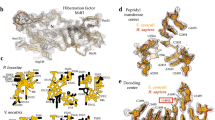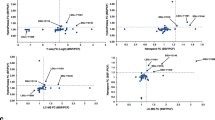Abstract
Microsporidia are eukaryotic parasites that infect essentially all animal species, including many of agricultural importance1,2,3, and are significant opportunistic parasites of humans4. They are characterized by having a specialized infection apparatus, an obligate intracellular lifestyle5, rudimentary mitochondria and the smallest known eukaryotic genomes5,6,7. Extreme genome compaction led to minimal gene sizes affecting even conserved ancient complexes such as the ribosome8,9,10. In the present study, the cryo-electron microscopy structure of the ribosome from the microsporidium Vairimorpha necatrix is presented, which illustrates how genome compaction has resulted in the smallest known eukaryotic cytoplasmic ribosome. Selection pressure led to the loss of two ribosomal proteins and removal of essentially all eukaryote-specific ribosomal RNA (rRNA) expansion segments, reducing the rRNA to a functionally conserved core. The structure highlights how one microsporidia-specific and several repurposed existing ribosomal proteins compensate for the extensive rRNA reduction. The microsporidian ribosome is kept in an inactive state by two previously uncharacterized dormancy factors that specifically target the functionally important E-site, P-site and polypeptide exit tunnel. The present study illustrates the distinct effects of evolutionary pressure on RNA and protein-coding genes, provides a mechanism for ribosome inhibition and can serve as a structural basis for the development of inhibitors against microsporidian parasites.
This is a preview of subscription content, access via your institution
Access options
Access Nature and 54 other Nature Portfolio journals
Get Nature+, our best-value online-access subscription
$29.99 / 30 days
cancel any time
Subscribe to this journal
Receive 12 digital issues and online access to articles
$119.00 per year
only $9.92 per issue
Buy this article
- Purchase on Springer Link
- Instant access to full article PDF
Prices may be subject to local taxes which are calculated during checkout




Similar content being viewed by others
Data availability
The data that support the findings of this study are available from the corresponding author on request. The cryo-EM density maps for the microsporidian ribosome have been deposited in the EM Data Bank with accession code EMD-4935 (overall state 1), EMD-4935—additional map 1—(overall state 2), EMD-4931 (LSU focused), EMD-4932 (SSU-body focused), EMD-4933 (SSU-head focused) and EMD-4934 (state 1, SSU-head focused). Coordinates for state 1 have been deposited in the Protein Data Bank under accession code 6RM3. Mass spectrometry data has been uploaded to PRIDE42 under project accession PXD013432.
References
Stentiford, G. D. et al. Microsporidia—emergent pathogens in the global food chain. Trends Parasitol. 32, 336–348 (2016).
Franzen, C. Microsporidia: a review of 150 years of research. Open Parasitol. J. 2, 1–34 (2008).
Higes, M. et al. How natural infection by Nosema ceranae causes honeybee colony collapse. Environ. Microbiol. 10, 2659–2669 (2008).
Didier, E. S. & Weiss, L. M. Microsporidiosis: not just in AIDS patients. Curr. Opin. Infect. Dis. 24, 490–495 (2011).
Corradi, N. Microsporidia: eukaryotic intracellular parasites shaped by gene loss and horizontal gene transfers. Annu. Rev. Microbiol. 69, 167–183 (2015).
Katinka, M. D. et al. Genome sequence and gene compaction of the eukaryote parasite Encephalitozoon cuniculi. Nature 414, 450–453 (2001).
Corradi, N., Pombert, J.-F., Farinelli, L., Didier, E. S. & Keeling, P. J. The complete sequence of the smallest known nuclear genome from the microsporidian Encephalitozoon intestinalis. Nat. Commun. 1, 1–7 (2010).
Curgy, J. J., Vavra, J. & Vivares, C. Presence of ribosomal RNAs with prokaryotic properties in Microsporidia, eukaryotic organisms. Biol. Cell. 38, 49–51 (1980).
Vossbrinck, C. R., Maddox, J. V., Friedman, S., Debrunner-Vossbrinck, B. A. & Woese, C. R. Ribosomal RNA sequence suggests microsporidia are extremely ancient eukaryotes. Nature 326, 411–414 (1987).
Vossbrinck, C. R. & Woese, C. R. Eukaryotic ribosomes that lack a 5.8S RNA. Nature 320, 287–288 (1986).
Rivera, M. C., Maguire, B. & Lake, J. A. Isolation of ribosomes and polysomes. Cold Spring Harb. Protoc. 2015, 293–299 (2015).
Haag, K. L. et al. Evolution of a morphological novelty occurred before genome compaction in a lineage of extreme parasites. Proc. Natl Acad. Sci. USA 111, 15480–15485 (2014).
James, T. Y. et al. Reconstructing the early evolution of fungi using a six-gene phylogeny. Nature 443, 818–822 (2006).
Peyretaillade, E. et al. Microsporidian Encephalitozoon cuniculi, a unicellular eukaryote with an unusual chromosomal dispersion of ribosomal genes and a LSU rRNA reduced to the universal core. Nucleic Acids Res. 26, 3513–3520 (1998).
Klinge, S. & Woolford, J. L. Ribosome assembly coming into focus. Nat. Rev. Mol. Cell Biol. 20, 116–131 (2019).
Ebersberger, I. et al. The evolution of the ribosome biogenesis pathway from a yeast perspective. Nucleic Acids Res. 42, 1509–1523 (2014).
Melnikov, S. V. et al. Muller’s ratchet and ribosome degeneration in the obligate intracellular parasites microsporidia. Int. J. Mol. Sci. 19, 1–12 (2018).
Ramrath, D. J. F. F. et al. Evolutionary shift toward protein-based architecture in trypanosomal mitochondrial ribosomes. Science 362, eaau7735 (2018).
Holmes, M. A. et al. Structure of the conserved hypothetical protein MAL13P1.257 from Plasmodium falciparum. Acta Crystallogr. Sect. F Struct. Biol. Cryst. Commun. 62, 180–185 (2006).
Rahaman, S. N. A. et al. Crystal structure and functional analysis of human C1ORF123. PeerJ. 6, 1–25 (2018).
Id, Y. F. et al. Identification of a novel zinc-binding protein, C1orf123, as an interactor with a heavy metal-associated domain. PLoS ONE 13, e0204355 (2018).
Ratje, A. H. et al. Head swivel on the ribosome facilitates translocation by means of intra-subunit tRNA hybrid sites. Nature 468, 713–716 (2010).
Devaraj, A., Shoji, S., Holbrook, E. D. & Fredrick, K. A role for the 30S subunit E site in maintenance of the translational reading frame. RNA 15, 255–265 (2009).
Polacek, N. et al. The critical role of the universally conserved A2602 of 23S ribosomal RNA in the release of the nascent peptide during translation termination. Mol. Cell 11, 103–112 (2003).
Desjardins, C. A. et al. Contrasting host-pathogen interactions and genome evolution in two generalist and specialist microsporidian pathogens of mosquitoes. Nat. Commun. 6, 1–12 (2015).
Gill, E. E. et al. Splicing and transcription differ between spore and intracellular life stages in the parasitic microsporidia research article. Mol. Biol. Evol. 27, 1579–1584 (2010).
Van Dyke, N., Baby, J. & Van Dyke, M. W. Stm1p, a ribosome-associated protein, is important for protein synthesis in Saccharomyces cerevisiae under nutritional stress conditions. J. Mol. Biol. 358, 1023–1031 (2006).
Ben-Shem, A. et al. The structure of the eukaryotic ribosome at 3.0 Å resolution. Science 334, 1524–1529 (2011).
Brown, A., Baird, M. R., Yip, M. C., Murray, J. & Shao, S. Structures of translationally inactive mammalian ribosomes. eLife 7, 1–18 (2018).
Petrov, A. S. et al. Structural patching fosters divergence of mitochondrial ribosomes. Mol. Biol. Evol. 36, 207–219 (2019).
Mastronarde, D. N. Automated electron microscope tomography using robust prediction of specimen movements. J. Struct. Biol. 152, 36–51 (2005).
Zheng, S. Q. et al. MotionCor2: anisotropic correction of beam-induced motion for improved cryo-electron microscopy. Nat. Methods 14, 331–332 (2017).
Zivanov, J. et al. New tools for automated high-resolution cryo-EM structure determination in RELION-3. eLife 7, e42166 (2018).
Rohou, A. & Grigorieff, N. CTFFIND4: fast and accurate defocus estimation from electron micrographs. J. Struct. Biol. 192, 216–221 (2015).
Grant, T., Rohou, A. & Grigorieff, N. CisTEM, user-friendly software for single-particle image processing. eLife 7, e35383 (2018).
Punjani, A., Rubinstein, J. L., Fleet, D. J. & Brubaker, M. A. CryoSPARC: algorithms for rapid unsupervised cryo-EM structure determination. Nat. Methods 14, 290–296 (2017).
Rappsilber, J., Mann, M. & Ishihama, Y. Protocol for micro-purification, enrichment, pre-fractionation and storage of peptides for proteomics using stagetips. Nat. Protoc. 2, 1896 (2007).
Silva, J. C., Gorenstein, M. V., Li, G.-Z. Z., Vissers, J. P. C. & Geromanos, S. J. Absolute quantification of proteins by LCMSE: a virtue of parallel MS acquisition. Mol. Cell. Proteom. 5, 144–156 (2006).
Emsley, P. & Cowtan, K. Coot: model-building tools for molecular graphics. Acta Crystallogr. Sect. D Biol. Crystallogr. 60, 2126–2132 (2004).
Adams, P. D. et al. The Phenix software for automated determination of macromolecular structures. Methods 55, 94–106 (2011).
Goddard, T. D. et al. UCSF ChimeraX: meeting modern challenges in visualization and analysis. Protein Sci. 27, 14–25 (2018).
Vizcaíno, J. A. et al. 2016 update of the PRIDE database and its related tools. Nucleic Acids Res. 44, 11033–11033 (2016).
Acknowledgements
We thank M. Ebrahim and J. Sotiris for their support with data collection at the Evelyn Gruss Lipper Cryo-Electron Microscopy Resource Center, all members of the Klinge laboratory for helpful discussions and critical reading of this manuscript and H. Molina from the Rockefeller University Proteomics Resource Center for help with mass spectrometry analysis. The Rockefeller University Proteomics Resource Center acknowledges funding from the Leona M. and Harry B. Helmsley Charitable Trust and Sohn Conferences Foundation for mass spectrometer instrumentation. We thank B. Vossbrinck for her help in editing the manuscript. J.B. was supported by a Swiss National Science Foundation fellowship (155515) and is a SciLifeLab National Fellow at Umeå University. C.R.V. acknowledges funding from the Hatch Grant Project no. CONH00786 and R. Tyler Huning. S.K. is supported by the Robertson Foundation, the Alfred P. Sloan Foundation, the Irma T. Hirschl Trust, the Alexandrine and Alexander L. Sinsheimer Fund and the National Institutes of Health New Innovator Award (no. 1DP2GM123459).
Author information
Authors and Affiliations
Contributions
J.B., C.R.V. and M.H. conceived the study. C.R.V. cultivated microsporidia and purified ribosomes. J.B. and M.H. performed all EM work, determined the cryo-EM structures and built the model. S.K., J.B., C.R.V. and M.H. interpreted the results and wrote and edited the manuscript.
Corresponding author
Ethics declarations
Competing interests
The authors declare no competing interests.
Additional information
Publisher’s note: Springer Nature remains neutral with regard to jurisdictional claims in published maps and institutional affiliations.
Supplementary information
Supplementary Information
Supplementary Figs. 1–7, Supplementary Tables 1–3 and Supplementary References.
Rights and permissions
About this article
Cite this article
Barandun, J., Hunziker, M., Vossbrinck, C.R. et al. Evolutionary compaction and adaptation visualized by the structure of the dormant microsporidian ribosome. Nat Microbiol 4, 1798–1804 (2019). https://doi.org/10.1038/s41564-019-0514-6
Received:
Accepted:
Published:
Issue Date:
DOI: https://doi.org/10.1038/s41564-019-0514-6
This article is cited by
-
Functional annotation of a divergent genome using sequence and structure-based similarity
BMC Genomics (2024)
-
A new family of bacterial ribosome hibernation factors
Nature (2024)
-
Microsporidian spores contain hibernating dimeric ribosomes
Nature Microbiology (2023)
-
A molecular network of conserved factors keeps ribosomes dormant in the egg
Nature (2023)
-
CryoEM reveals that ribosomes in microsporidian spores are locked in a dimeric hibernating state
Nature Microbiology (2023)



